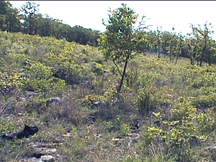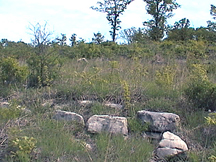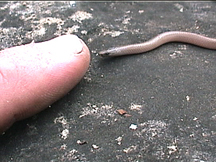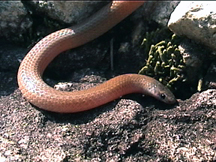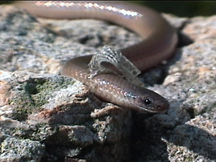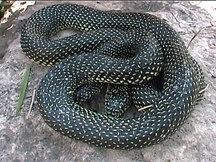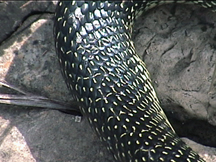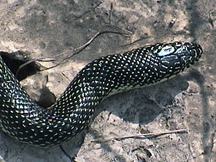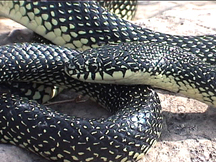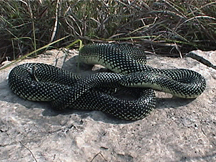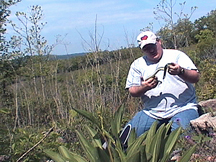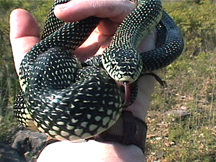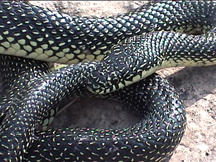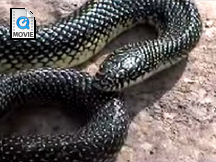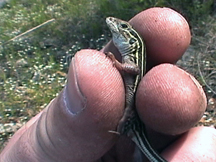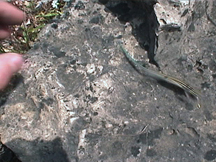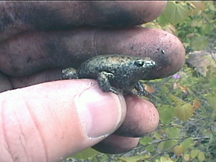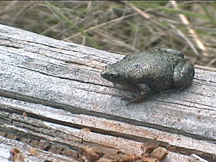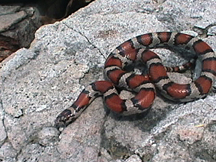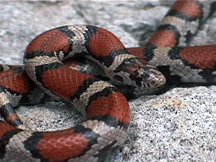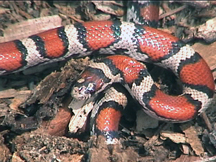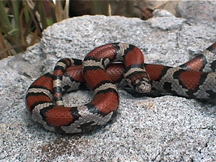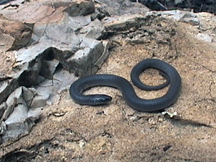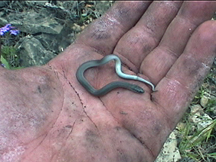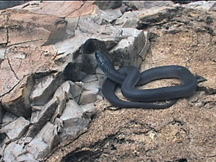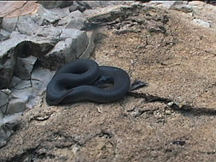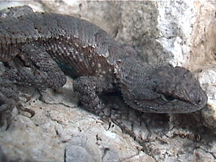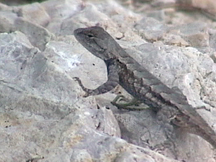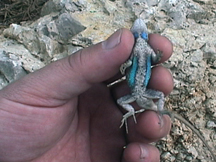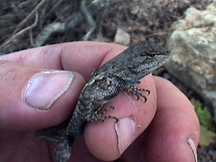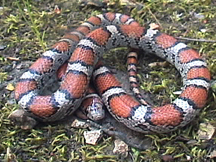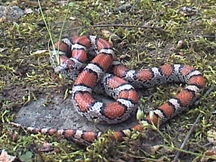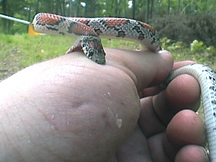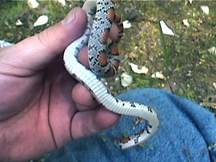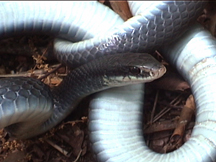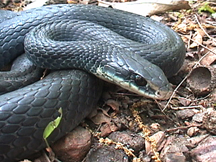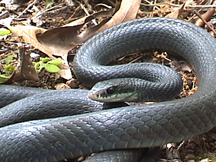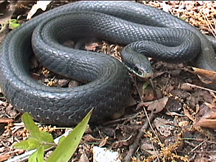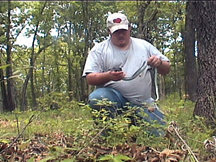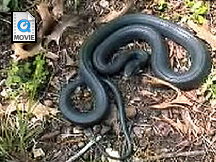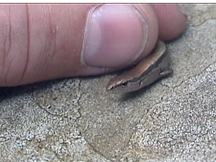
Weather: Sunny with scattered clouds, sometimes sun overcast but never long. Still to very mild breezes. High of 78 degrees.
Location: Taney County, Missouri
Herper: Matt Ricklefs
Quote of the day: “The Glorious Glades”
Perseverance. One of the rules, albeit a difficult one, is staying with the plan even though some days do not pay off. I had done moderately well on Wednesday, it was a good start. On Thursday, I checked a couple of areas that I spent more time driving then anything. When I did get to where I was going, it did not turn out to be a very good location. I went back to the place I had been on Wednesday and my bad luck held out. I was totally skunked on Thursday. Since I only had three days to herp, every day counted. You have to put in some bad days and identify habitats and areas that may or may not pay off. That day for me was Thursday. However, although I did not catch anything, I did see some nice areas, and enhanced my understanding of herping in southern Missouri. I did see a roadrunner in the morning crossing the road, that was pretty cool.
Today was my last day to herp. I had mentioned in my posting on Wednesday that I choose to herp Wednesday through Friday, as those were the most favorable days weather-wise, with Friday being the best. On Thursday night I was disappointed from my lack of finding things. My mother-in-law, wife and I did take in the Andy Williams show and that cheered me up. Classic rock is my favorite kind of music, but being a musician does open me to many kinds of music. I can relate to reggae, I really love Marley, some country, punk, heavy metal, alternative, classical – both traditional like Mozart and also contemporary like the great John Williams, western swing and “cowboy” music and even the crooners like Andy. For being seventy-seven years old, he put on a great sheoow (as Ed Sullivan would have said). I also mention John Williams because I had purchased the soundtrack for Star Wars: Revenge of the Sith and that was the music I was listening to en route to herping which as quite exhilarating. Thanks for allowing me that tangent.
Now you know my state of mind on Friday. I had to do well, I really wanted to have some cool stuff to share and post. I'm sure we all know the feeling.
I started early as it was in the mid fifties by 8:00 a.m. I did have to do some reconnaissance work to find the right area, but my searching on the web prior to leaving, and an e-mail to someone related to where I was going helped me out. I arrived to see an area that I now understand is a very good glade. It was a great mix of forest, medium shrub and low scrub. It had many areas where there were openings for sun to get through, and scattered throughout were rock outcrops and loose rock. The hillside I was on faced due south to southwest. Perfect! It was much more green than then glade I was at the other day, and the flora was much more varied. It was also nice that there was a good area to park close by. In southern Missouri the roads are narrow with almost no shoulder and in some places there is actually no shoulder, so this area to stop and park was most welcome. I went through a small area of trees and it opened to the glade. I could already hear fence lizards everywhere. I was praying that this was my day. It started with a welcome find. Under a small bramble of rocks was a Flathead Snake (Tantilla gracilis).
This one was actually pretty good sized at about six inches. It was ready to shed and just capturing it took off some of the old layer of skin. I decided to take some video before then shed it out and get some good footage of it in full hue. Normally I would never shed something out, as it will do it fine when it is ready. This one was obviously ready to go so I knew it would not be harmed by me helping it along. It came off easily and quickly by me just holding the snake and letting it wriggle out. It then repaid me by holding still for some great shots. Snakes and other herps of this size are usually hard to get to cooperate for photographs. You have to be very gentle and wrangle them with care. It can also be problematic to get nice close pics with detail of something so tiny. It helps to have the right equipment and patience. Some of my pictures early in the year were not that great. I was determined to do all I could to get good clear footage and try to get a decent composition.
Things were looking up now. I had seen a Western Worm Snake Wednesday, and a Flathead Snake so far today. Never underestimate the coolness of the little things. It’s always great to find the “trophy” herps, but the little things add a nice touch as well, It also helps you to keep going finding even little things on the way as you know you are in a herpetologically active area.
Before I left, Jim had mentioned that a good find would be a Speckled King. In Taney County you are far enough from the “Desert King” influence to the west and the “Black King” influences to the east and you end up with a more or less “pure” Speckled King. My next find was one I was glad for, a Speckled Kingsnake (Lampropeltis g. holbrooki).
It was a big one too at about forty-three inches long. It was under a rock right by an outcropping of rock in an open area. You always hear “look for south facing rocky hillsides” and you know what, its true. This snake was perfect except for what appeared to be a damaged and dried exverted hemipenis. It did not seem bad off, as it was otherwise healthy looking. It was REALLY pretty. It had a dot or small line on each scale with no noticeable barring. Not knowing what else I may find, I spent quite a bit of time getting footage of this one. As usual I let this “king” go after I was satisfied I got the best footage I could. The snake put on a strange defensive display, where it shook it's head from side to side. Here is a video clip showing the behavior.
I was extremely encouraged at this find.
Here goes another slight tangent… I choose to use a digital camcorder. I will be investing in a nice digital camera also as you get much better resolution. However, with camcording you get the whole experience. The weird shots of just ground or your leg as you wrangle, the thrill in your voice or others at the find. You get any funny things you or others say. You can capture all the info on tape then go back and review – which actually can take a bit of time. You get weird movements and behaviors that may be hard to capture in a still. You just get the overall picture. Sometimes, you just look like a doofus. I have recently done some shots with the camcorder propped on something so I can get some footage of me with whatever to help show scale. I must say it has proven for some embarrassing if not hilarious footage. If you can’t laugh at yourself, rest assured someone would be able to. Still are better for REALLY nice pics though, so that is my next step. It’s nice to go with someone like Jim, because he can take stills and I can camcord. Being alone, it is better to have some diversity for the end posting. And now back to “Herping with Rambling Matt”.
I took some time for some habitat shots as the response from forums and e-mail show people do like to get a view of what kind of area you are finding stuff in. I also found a shed about three to four feet long. It was unmarked and I could not identify exactly what it was. I also spent a little time trying to get some good footage of a fence lizard, but to this point they were quite elusive. I had to dig into my old lizard catching bag of technique before I got anything good, but that is yet to come. I also turned a rock and experienced how fast a racerunner can get away from you. I did finally turn up another Flathead Snake. This one was in shed but not ready yet and was smaller at about four inches.
The next find I was ready for. I turned a rock and immediately grabbed a juvenile Prairie-Lined Racerunner (Cnemidophorus sexlineatus viridis).
In “The Amphibians and Reptiles in Missouri” Johnson notes that this is the subspecies found in Taney County although there is some possible integration with the Six-Lined Racerunner. This one was about four inches with tail. It is hard to work with squirming little lizards that want to bolt as soon as they have a chance. You just don’t want to restrict them and accidentally hurt them. After the best shots I could get, I let this one go on its way.
The next find was somewhat of a surprise. I had found another species in Kansas so it should have been somewhat expected, but finding an amphibian on the hillside is still a little strange. It was an Eastern Narrowmouth Toad (Gastrophryne carolinensis).
These are very cool little toads. I have always liked the “Bufo” toads, and these little guys are right up on my list. The Eastern species is cool as it had the mossy or bark-like mottling that the Great Plains Narrowmouth Toad lacks. These are squat stubby little toads and this one was about one and a half inches. It was pretty cooperative for the most part, but did try a few daring escapes. The hillside was fairly dry, but there were some areas of standing water, like from a very small spring or drainage. It pooled in some of the open areas with just a moderate flow. The toad was found by a rock outcropping in the shade under a rock that did hold some moisture underneath. After getting some good pics, I did let it go back under its same rock. Whenever Jim or I capture something for documenting we always let it go back under the rock or in the area you found it. You do need to set the rock back down first and make all efforts to make the area back the way it was, then the critter can go back where it was. In this case it was even more important as this rock did hold moisture and I did not want the toad to dry out. There are times and with some herps that this is not as important. On road cuts for example, the rock is always changing and some herps will just go their own way anyway. It is good management and discipline to keep things as you found them whenever it is feasible and possible though.
The next find was another “biggie”. Not far from where I let the toad go was another small rock outcrop with a small pile of flat rocks by a log that had been decaying and had a lot of bark and leaf litter. Now, most herpers have said the same thing I said to myself – “There has got to be something here”. Usually that does not work as you will turn the “perfect” rock, board or tin and find nothing. Today however there was a Red Milk Snake (Lampropeltis t. syspila).
This one was about twenty inches long and was beautiful. This is another species that in other areas integrates with either the Great Plains Milk or the Eastern Milk but here they are essentially “pure” syspila. After getting some great shots of a fairly cooperative milk snake, I carefully placed the rock back down the way it was and moved the leaf and bark litter back around it as close as I could get it and released the snake
Moving on, I did find and video another snake shed. This one was very similar to the first one. I also found another Eastern Narrowmouth Toad. This one was almost an exact replica of the first one. This one was also found in a similar situation of moisture under a rock.
Under a plate sized rock I found a Rough Earth Snake (Virginia striatula).
This one was small, at about four inches long. It was fairly cooperative for photographing. It’s funny that what most people would see is a bland, nondescript snake is actually pretty cool and a good find to a true herper. I was happy. It was another thing I could add to my list.
It was about 1:30 p.m. and I still had a bit of time left before I needed to get my rental car back. I went back to the car for lunch and then drove around just about fifteen minutes to see if I missed anywhere else. I ended back at the same spot. Not far from where I parked again were some rocks. The rocks were intermixed with mature trees but there was also a lot of ground clutter. It was close enough to the glade that it did get some sun and would be a quick slither to the glade. There were some downed trees and rock where I was finally able to catch a Northern Fence Lizard (Sceloporus undulatus hyacinthinus).
It was small, about four and a half inches with tail, but considering they where everywhere and I still had not gotten a good shot, I was happy.
I turned a rock not far from my car and found another red milk snake.
This was the second of two snakes to bite me. Of course neither caused any pain, but rather it is just fun to have them chomp on like they are true killers. This one was about fifteen inches long and lighter than the first. It had almost no markings on its belly, which was almost pure white. It was really cool and I got some good pics then let it be on its way.
I was getting close to the end of my day. I wandered around this open area which was actually quite vast. After walking around a bit I knew it was my day. Laying out in the leaf litter with its head propped up on a log was a racer.
Identifying racers is a little tricky and they are the subject of some debate. Many believe that some species are in actuality just color variations. I have found Blue Racers (Coluber c. foxi), Yellow-Bellied Racers (Coluber c. flaviventris) and Southern Black Racers (Coluber c. priapus). Depending on how you view this I have captured three subspecies. To make matters worse they do intergrade. I have also found some that show this integration by showing coloration of both. According to Johnson, Taney County is about two counties away before integration begins with the Southern Black Racer. However visually, this racer looks like it is a Southern Black Racer. Now, this is not scientific and even the experts vary in opinion so we will just call this one a racer. It was good sized at about forty inches long. It held its ground, then just when it started to move, I grabbed it. It did not make an attempt to bite but rather just tried to escape. Upon holding it, it balled up. I placed it on the ground to start taking some pics and it showed a peculiar behavior. It would curl in next to itself in a kind of open eight formation. It was very similar to what you see exhibited by a Saw-Scaled Viper. Here is some video of this behavior.
It was pretty interesting. I got several good shots then let it go. However, it did not want to go. Since I found it out, I thought once I let it go and stepped away it would take off. It didn’t. It stayed balled up. Since I didn’t want to leave it out in the open for predators I found a fallen tree close by with a lot of leaf litter. I placed it down in and it moved in a little then stopped. Then I just covered it over the rest of the way with leaves. Then I walked around a little more.
Near the end of the day I caught something I had been wanting to catch, a Ground Skink (Scincella lateralis).
It was typically sized at about two and a half inches long with tail. Flipping rocks in some areas you run across these, but they are often difficult to catch. They are also hard to hold on to as they are very delicate. I only got a few shots. Most of the time you can get a “natural” shot, meaning the animal in the habitat without constraint. With small or fast moving things this can be hard. There are many techniques to try and get an animal to pose, but sometimes you just have to settle for the in-hand shot
Well, that was the end of the day. Had I know that this area was so good I would have come here the full three days. As it was I did get one great day. I will be back. There is more to learn about this area and other herps to be found. My big hope for this trip was to find a Western Pigmy Rattlesnake. I did not find one, but I am one step closer to understanding where they may be and what to look for. I would like to take a moment now to specifically thank all the people who gave me information and tips on what to look for and where to start out. Without your help my trip would not have been as successful as it was. Thank you for all your help!! The season still has some time left, so until next time…
Happy herpin’!

